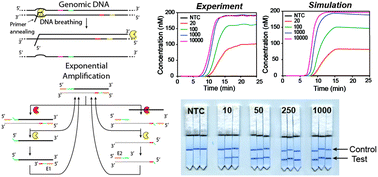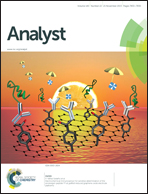Isothermal strand displacement amplification (iSDA): a rapid and sensitive method of nucleic acid amplification for point-of-care diagnosis†
Abstract
We present a method of rapid isothermal amplification of DNA without initial heat denaturation of the template, and methods and probes for (a) real-time fluorescence detection and (b) lateral flow detection of amplicons. Isothermal strand displacement amplification (iSDA) can achieve >109-fold amplification of the target sequence in <20 minutes at 49 °C, which makes it one of the fastest existing isothermal DNA amplification methods. iSDA initiates at sites where DNA base pairs spontaneously open or transiently convert into Hoogsteen pairs, i.e. “breathe”, and proceeds to exponential amplification by repeated nicking, extension, and displacement of single strands. We demonstrate successful iSDA amplification and lateral flow detection of 10 copies of a Staphylococcus aureus gene, NO.-inducible L-lactate dehydrogenase (ldh1) (Richardson, Libby, and Fang, Science, 2008, 319, 1672–1676), in a clean sample and 50 copies in the presence of high concentrations of genomic DNA and mucins in <30 minutes. We also present a simple kinetic model of iSDA that incorporates competition between target and primer-dimer amplification. This is the first model that quantitates the effects of primer-dimer products in isothermal amplification reactions. Finally, we demonstrate the multiplexing capability of iSDA by the simultaneous amplification of the target gene and an engineered internal control sequence. The speed, sensitivity, and specificity of iSDA make it a powerful method for point-of-care molecular diagnosis.



 Please wait while we load your content...
Please wait while we load your content...